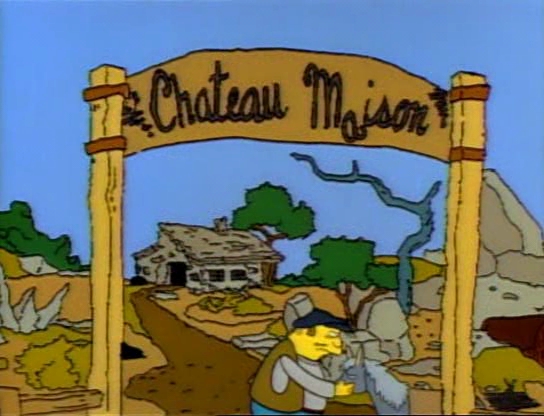Wine and Antifreeze

The eleventh episode of the first season of The Simpsons aired on April 15, 1990. In the episode, titled “The Crepes of Wrath,” Bart cherry bombs a toilet at school, unintentionally victimizing the elderly mother of the man we then believe to be Principal Seymour Skinner. As punishment, Bart is entered into a foreign exchange program and is sent to a winery in France. While the brochure made Chateau Maison out to be an idyllic vacation spot (and not something we’d consider a punishment), as seen above, reality was less kind. The young Simpson lad was hardly on vacation. As Wikipedia describes in its entry for the episode, Bart was “starved while being made to carry buckets of water, collect and crush grapes, sleep on the floor, and test wine contaminated with antifreeze.”
This is fiction, of course. Children aren’t shipped off to France as punishment for blowing up toilets. They aren’t turned into wine-making slaves and rarely, if ever, sleep on the floor as part of such punishment. And they don’t taste-test antifreeze-laden wine, because wine contaminated with antifreeze doesn’t exist, at least not intentionally.
Except for that one time in 1985.
When we think of where wine comes from, France is top of mind (as it was for the Simpsons writers) and perhaps California is second. Austria probably doesn’t rank too highly on that list, probably because it’s only the sixteenth largest wine producer, nestled between Greece and Serbia. (France tops the list, with Italy and Spain rounding out the top three. The U.S. is fourth.) It has a long history of wine making dating back 4,000 years, and for most of the 20th century, Austria provided wine in large quantities to Germany. But in the early 1980s, the quality of Austrian wine nose-dived; as the New York Times reported, “harvest failed to produce the needed amounts [of grapes], or when they did, as in the abundant 1982 harvest, the grapes were sour.” Wine peddlers, with lots of seemingly worthless stock, discovered that diethylene glycol — a “colorless, practically odorless, [and] poisonous” organic compound found in antifreeze — would turn the acidic wine they had into something sweet and desirable, except for that whole “poisonous” thing. But what purchasers didn’t know wasn’t the brokers’ problem. So they mixed the wine with antifreeze and hoped for the best.
The poison was nearly undetectable. As the above-mentioned Times article noted, one of the vintages of tainted wine even managed to win an industry award, despite the fact that a judge “wondered where some of the growers’ wines got that much body.” And even though drinking antifreeze can cause brain damage, kidney failure, and ultimately, death, no injuries or ailments were directly linked to the tainted wine. So if no one tasted the difference, and no one got sick, how did the scandal come to light?
The blame (or perhaps, credit) for that goes to the greed of an already unscrupulous wine broker. He tried to deduct the cost of the antifreeze from his taxes. Thankfully, the tax inspector knew better, and realized that diethylene glycol isn’t used in the wine making process — at least not legitimately. Demand for Austrian wine plummeted nearly overnight and did not fully rebound for over a decade.
Bonus fact: Most likely, there were a number of people who fell ill due to the adulterated Austrian wine distributed in the 1980s — the secrecy behind the scandal simply keeps us from being able to link the two. But there’s another reason why there are no known victims. The Centers for Disease Control’s page on ethylene glycol suggests that the mixture may have contained part of the treatment for such poisoning: “adverse health effects can be delayed significantly by the co-ingestion of alcohol.”
From the Archives: Wine and Cheese With the Queen: Random guy grabs a late night snack with Queen Elizabeth, but wasn’t invited.
Related: “Wine for Dummies,” 4.6 stars on 55 reviews. A “Look Inside!” search yields zero mentions of either antifreeze or ethylene glycol, but 28 mentions of “Austria” or “Austrian.”
